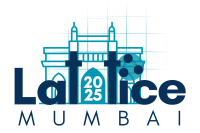Speaker
Description
What is the pattern and mechanisms behind the labyrinthine spectrum of excited hadrons?
Many open questions in this regard hinge on a precise understanding of the three-body dynamics in continuum and in finite-volume settings. One curious case is that of the lightest hadron — the pion — with the mass of 1/7th of that of the nucleon. Its excited state (pi(1300)) is nearly as heavy as the excited state of the nucleon (the Roper N*(1440)) — or 10 times as heavy as the ground state.
In my talk, I show how this problem can be tackled from Lattice QCD [https://arxiv.org/abs/2510.09476] from determining the finite-volume spectrum to mapping it to the infinite-volume amplitude and determining the resonance pole positions. Using partial input from CHPT, robust extrapolations to the physical point are made. Our results support the existence of the state (debated in some experimental analyses) overlapping with the average values from phenomenology.
| Parallel Session (for talks only) | Hadronic and nuclear spectrum and interactions |
|---|

